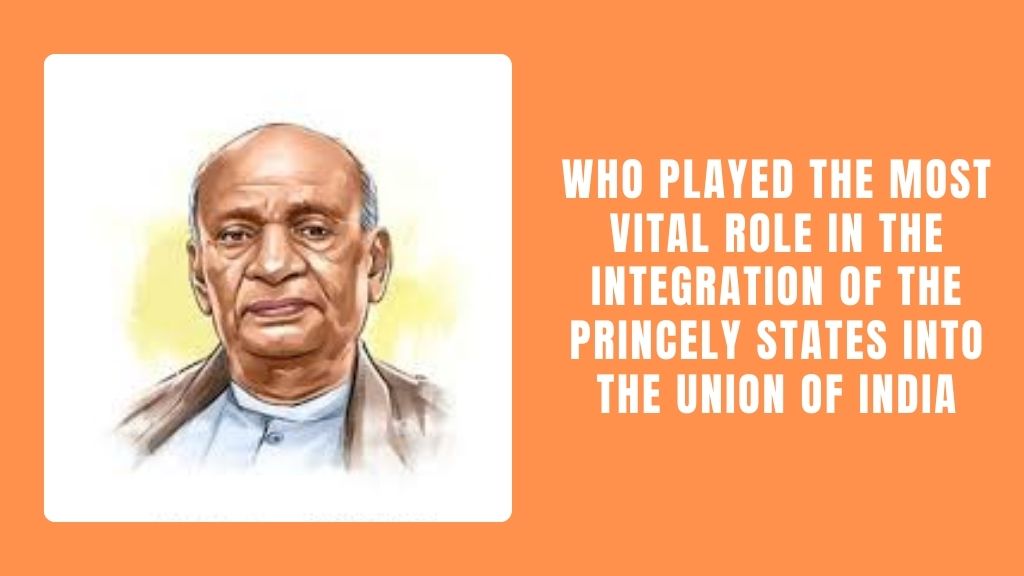Who played the most vital role in the integration of the princely states into the Union of India? This question is significant in understanding the formation of modern India. When India gained independence in 1947, it was not a unified nation but a land divided into British-controlled territories and over 560 princely states. These princely states had the option to join India, Pakistan, or remain independent. The integration of these states into India was one of the biggest challenges faced by the newly formed government.
The person who played the most crucial role in this process was Sardar Vallabhbhai Patel, the first Deputy Prime Minister and Home Minister of India. His leadership, diplomatic skills, and firm approach were key in unifying the nation.
Understanding the Princely States Before Independence
Before India’s independence, the subcontinent was divided into two types of territories:
- British-controlled provinces: These were directly governed by the British government through the Viceroy and British administrators.
- Princely states: These were regions ruled by local kings, maharajas, and nawabs. They had their own governance systems but were under British protection.
These princely states were not directly controlled by the British, but they had treaties with the British government for defense and foreign relations. After independence, these states had three options:
- Join India
- Join Pakistan
- Remain independent
The challenge was to bring all these princely states together to form a united India. This was not easy because some rulers wanted to remain independent, while others were unsure about their future.
Also read: What Will You Do When You Observe Classmates Making Fun of a Learner with Learning Disability?
Sardar Vallabhbhai Patel’s Role in Integration
1. Leadership in the Integration Process
Sardar Patel, known as the “Iron Man of India,” took charge of the integration of princely states. As the Home Minister, he worked with his secretary, V.P. Menon, to convince the rulers to join India. Patel knew that without the princely states, India would remain divided and weak. He took the responsibility of unifying India under one nation.
2. The Instrument of Accession
To merge the princely states into India, Patel and Menon introduced the Instrument of Accession, a legal document that allowed rulers to officially join India. Patel used a mix of persuasion, diplomacy, and firm action to make the rulers sign this document.
3. Strategies Used by Patel
Patel used different strategies to convince the rulers:
- Negotiation and Assurance: Patel assured the rulers that they would be treated with respect and that their privileges would be protected.
- Political and Economic Pressure: Some rulers were hesitant, but Patel used political and economic pressure to convince them.
- Military Action: In cases where rulers refused to join India and posed a threat, Patel used military force to integrate the states.
4. Dealing with Difficult Princely States
Some princely states were more challenging to integrate. Patel handled them using different approaches:
Hyderabad
The Nizam of Hyderabad wanted to remain independent. Hyderabad was a large and powerful state in the heart of India. Patel tried negotiations, but when the Nizam refused, Patel launched Operation Polo in September 1948, a military action that resulted in the quick and peaceful integration of Hyderabad into India.
Junagadh
The ruler of Junagadh, a small state in present-day Gujarat, chose to join Pakistan, even though the majority of the population wanted to join India. Patel used military and political pressure, and in November 1947, a public vote was held where people chose to join India.
Kashmir
Maharaja Hari Singh of Jammu and Kashmir hesitated to join either India or Pakistan. However, in October 1947, Pakistan-backed forces attacked Kashmir. The Maharaja then signed the Instrument of Accession, and Indian troops were sent to defend Kashmir.
V.P. Menon’s Contribution
V.P. Menon was a key figure in the integration process. As a senior bureaucrat, he worked closely with Patel and helped draft the legal framework for accession. His negotiation skills played a crucial role in convincing many rulers to join India without conflict.
Challenges in the Integration Process
The integration process was not smooth. Several challenges had to be overcome:
- Rulers’ Resistance: Many rulers were reluctant to give up their power and wanted to remain independent.
- Religious and Political Differences: Some states had rulers of one religion and a majority population of another, leading to conflicts.
- Pressure from Pakistan: Pakistan tried to influence some princely states to join them, especially Kashmir and Junagadh.
- Geographical Challenges: Some princely states were located in different parts of the country, making integration complex.
Impact of the Integration
Patel’s efforts resulted in the successful integration of princely states, which had several benefits:
- Created a United India: Without Patel’s leadership, India could have remained divided into small independent states.
- Ensured National Security: A divided India would have been vulnerable to external threats.
- Promoted Economic Development: A united India allowed for better economic planning and growth.
- Strengthened Democracy: The integration of states helped establish a democratic system where all citizens had equal rights.
Legacy of Sardar Vallabhbhai Patel
Sardar Patel is remembered as the architect of India’s unity. His contributions were so significant that his birthday, October 31, is celebrated as National Unity Day in India. In 2018, the Indian government honored him by unveiling the Statue of Unity, the world’s tallest statue, in Gujarat.
Comparison with Other Leaders
While Patel played the most vital role in integrating the princely states, other leaders also contributed to the process:
- Jawaharlal Nehru: As the first Prime Minister, he focused on building a democratic and socialist India.
- Mahatma Gandhi: His principles of non-violence influenced many rulers to join India peacefully.
- Lord Mountbatten: The last British Viceroy supported Patel’s efforts and helped in persuading rulers to join India.
Also read: Why Did William Jones Feel the Need to Study Indian History Philosophy and Law?
Conclusion
Who played the most vital role in the integration of the princely states into the Union of India? Without a doubt, Sardar Vallabhbhai Patel was the main architect of India’s unity. His leadership, diplomacy, and strong will ensured that India became one nation. His efforts, supported by V.P. Menon, created the modern political map of India. The integration of the princely states was one of the biggest achievements in Indian history, ensuring stability and unity for the newly independent nation.
Patel’s legacy continues to inspire India, reminding us of the importance of unity, strength, and decisive leadership. His vision and determination helped lay the foundation of the strong and diverse nation that India is today. Without his efforts, the map of India could have been very different, and the nation’s development could have faced many more obstacles.

